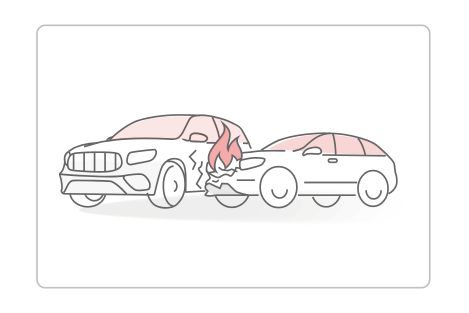
Written by Kayla Jane Barrie Updated on Feb 24, 2025 6 mins read

T-bone, or side-impact, accidents are dangerous and unfortunately common in Ontario. Whether at a busy intersection or when merging on a highway, these collisions can cause severe damage to vehicles and seriously injure people involved.
In this blog post, we will explore the causes and insurance consequences of T-bone accidents, how fault is determined, and what steps to take if you find yourself involved in such an incident.
T-bone accidents, also known as side-impact or broadside collisions, occur when the front of one vehicle hits the side of another. These accidents often happen at intersections and can cause severe damage and injury due to the limited protection on vehicle sides.
These accidents are hazardous because the impact occurs on the side of the car, leaving less protection for occupants. The force in a t-bone collision moves the driver and passengers sideways, increasing the chance of contact with the car's window or door.
They typically occur when one driver fails to yield the right-of-way. This often happens at intersections controlled by traffic lights or stop signs. For instance, a driver making a dangerous left turn might assume another motorist will stop at a yellow light. If the driver proceeds through the yellow light, they could hit a turning car. Similarly, a driver might improperly pass through a stop sign and strike the side of another vehicle in the intersection.
The impact of T-bone accidents can be devastating due to the nature of the collision. Common consequences include:
One of the most common questions about these types of accidents is who is at fault, and finding fault isn’t always cut and dry in insurance.
The driver at fault in a T-bone accident is the person who was acting negligently on the road by not following traffic signs or driving illegally. For instance, the driver who made the left turn is usually to blame in a crash. Since it is not always the case that the left-turning driver drove negligently, the fault will lie with the incautious driver.
Usually, the driver making the turn is at fault, although there are exceptions, such as when the other driver was speeding or running a red light.
Here are some examples:
In some cases, neither driver may be at fault. Poorly designed roads or malfunctioning traffic signals could lead to a claim against municipalities or construction companies. Also, a vehicle defect that causes a driver to be unable to stop could hold the car manufacturer accountable.
If you are found to be at fault for a t-bone accident, your premiums will likely increase. The severity of the accident and your driving history also play a role in determining the extent of the increase. Different insurance companies have varying underwriting guidelines, so the premium adjustment may differ depending on the insurer.
Insurance companies typically adjust premiums in one of three ways: by increasing the base rate, adding a surcharge, or updating your loss history. The base rate is the starting point for calculating your premium, and it may be adjusted upward after an accident. A surcharge is an additional fee added to your premium for a specific period, typically lasting several years. The accident will also be added to your loss history, which can impact your future premiums by making you a higher-risk driver.
To minimize the premium increase after a t-bone accident, you can take several steps. If you believe you were not at fault, dispute the determination with your provider. Maintaining a good record by avoiding traffic violations and accidents can also help keep your costs low. Shopping around for insurance quotes from different companies can ensure you are getting the best rates.
Additionally, some companies offer accident forgiveness programs that can waive or reduce premium increases for certain types of accidents.
T-bone collisions typically occur when a driver fails to yield the right of way, which can happen for various reasons. Here are some examples:
Here are two examples of what a T-bone accident can look like and how it can be handled:
Example one: John was driving through an intersection when another driver, Lisa, ran a red light and collided with his car. John sustained minor injuries, and his car was severely damaged.
They exchanged insurance information and filed claims with their respective insurance companies. John's insurance initiated a claim against Lisa for the damages. After reviewing the settlement offer, John's car was repaired, and he received reimbursement for his medical expenses. Both companies finalized the claim, and John was back on the road with his car fully repaired and his medical expenses covered.
Example two: Emma was driving her SUV when Frank, who was speeding, failed to stop at a stop sign and t-boned Emma's SUV. Emma sustained injuries, and her SUV suffered extensive damage. Both drivers exchanged insurance information, and the police created an accident report.
Emma filed a claim against Frank’s provider and gave photos of the damage and medical records. Frank’s company offered a settlement to cover the repairs and Emma's medical expenses, which Emma's company reviewed. The repair shop billed Frank’s insurance company directly, and Emma received reimbursement for her medical expenses. Finally, both companies finalized the claim, and Emma got her SUV repaired and her medical expenses covered.
Getting into a T-bone collision can be overwhelming. Here are the steps to take after the event:
It’s possible to experience whiplash from a T-bone accident. It happens when the neck is abruptly jolted back and forth, which is common in side-impact collisions like T-bone accidents. This can lead to injuries in the neck muscles and ligaments, resulting in symptoms such as neck pain, stiffness, and headaches. If you think you have whiplash, it's important to seek medical attention.
T-bone accidents can be deadly because the side of a vehicle has less protection. The severity of depends on factors such as vehicle speed, point of impact, and safety features deployed. These accidents can lead to severe injuries or fatalities, especially for those seated on the side of the vehicle that is hit.
A side-impact collision, also known as a T-bone collision, occurs when the front of one vehicle crashes into the side of another, forming a "T" shape at the point of impact. This collision often happens at intersections or when one vehicle fails to yield the right of way.
T-bone accidents are severe and can have long-lasting impacts on those involved. Understanding the common causes and consequences and how fault is determined can help you navigate the aftermath of such an incident. Remember to stay calm, prioritize safety, and have your Ontario car insurance up-to-date.
| Categories | Auto |
|---|---|
| Tags | Auto Coverage |
Read our insurance blog to get helpful tips, information and news.
Has your car been totalled in an accident? Is your car a write off? Learn about vehicle write offs for a total loss insurance claim.
Get the facts on Toronto's auto theft problem. We break down the data, reveal the most-stolen vehicles (including the Honda CR-V and Lexus RX 350), and show which neighbourhoods are most affected.
Dive into the world of auto theft with our blog on the most stolen cars in Canada. See the most stolen cars across Canada, including provincial lists for Ontario and Quebec, and learn how high-risk models can affect your car insurance premiums.
Drive safe this winter! Check out these tips for driving in snowy and icy conditions in Ontario. Get other helpful info and FAQs on winter driving.